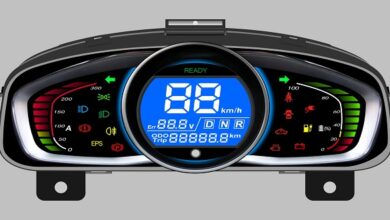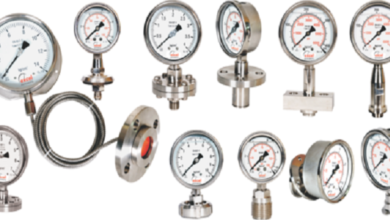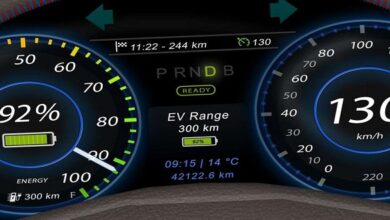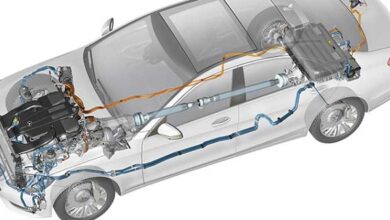Indicators and hazard circuit – Rover

Note how the hazard switch, when operated, disconnects the ignition supply from the flasher unit and replaces it with a constant supply. The hazard system will therefore operate at any time but the indicators will only work when the ignition is switched on. When the indicator switch is operated left or right, the front, rear, and repeater bulbs are connected to the output terminal of the flasher unit, which then operates and causes the bulbs to flash.
When the hazard switch is operated, five sets of contacts are moved. Two sets connect left and right circuits to the output of the flasher unit. One set disconnects the ignition supply and another set connects the battery supply to the unit. The final set of contacts causes a hazard warning light to be operated. On this and most vehicles the hazard switch is illuminated when the sidelights are switched on. When operating in hazard mode the bulbs would draw 7.8 A (94 W/12 V).
However, this current will peak much higher due to the cold resistance of the bulbs. In the circuit shown, the top fuse is direct from the battery and the other is ignition controlled.
With the ignition switched on, fuse 1 in the passenger compartment fusebox provides a feed to the hazard warning switch on the G wire. Provided the hazard warning switch is in the off position the feed crosses the switch and supplies the flasher unit on the LG/K wire.
When the switch control is moved for a right turn, the switch makes contact when the LG/N wire from the flasher unit is connected to the G/W wire, allowing a supply to pass the right-hand front and rear indicator lights and then to earth on the B wire.
When the switch control is moved for a left turn, the switch makes contact with the G/R wire, which allows the supply to pass to the left-hand front and rear indicator lights and then to earth on the B wire. The action of the flasher unit causes the circuit to ‘make and break’.
With the ignition switched on, fuse 1 in the passenger compartment fuse box provides a feed to the hazard warning switch on the G wire. Provided the hazard warning switch is in the off position the feed crosses the switch and supplies the flasher unit on the LG/K wire.
When the switch control is moved for a right turn, the switch makes contact when the LG/N wire from the flasher unit is connected to the G/W wire, allowing a supply to pass the right-hand front and rear indicator lights and then to earth on the B wire. When the switch control is moved for a left turn, the switch makes contact with the G/R wire, which allows the supply to pass to the lefthand front and rear indicator lights and then to earth on the B wire. The action of the flasher unit causes the circuit to ‘make and break’.
Wiper circuit – Ford
similar to that used on many Ford vehicles. Note that the two sets of switch contacts are mechanically linked together. The switches are shown in the ‘off’ position. A link is shown to a headlamp cleaning relay (if fitted) to allow operation of the headlamp washers as the screen washers are used. This will only occur if the headlamps are also switched on.
The motor is a three-brush PM type and contains a parking switch. Following the top terminal of the motor, as shown, results in a connection to earth via the control switch and the limit switch. This is to achieve regenerative braking.
Wiper blade pressure control
Valero has produced a new rear wiper module offering an original solution to these problems in the form of a specific, integrated electronic control system. This system is designed around an H-bridge power stage, which has no relays. This eliminates all switching noise. The control algorithm provides pinpoint management of wiper speed; it slows the blades at the end of each cycle, thus cutting out turning noise.
Last word
Note: an H-bridge uses four power devices that are connected to reverse the voltage across both terminals of a load. This is used to control the direction of a motor.
Tattoos have come a long way from being a taboo to a popular form of self-expression. While the decision to get inked is a personal one, it is important to consider various factors like design, placement, and aftercare. With proper research and precautions, getting a tattoo can be a fulfilling and exciting experience





